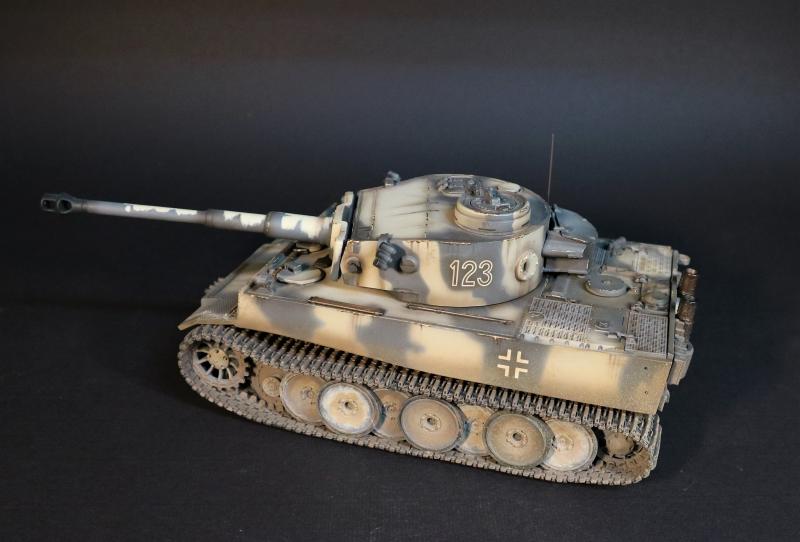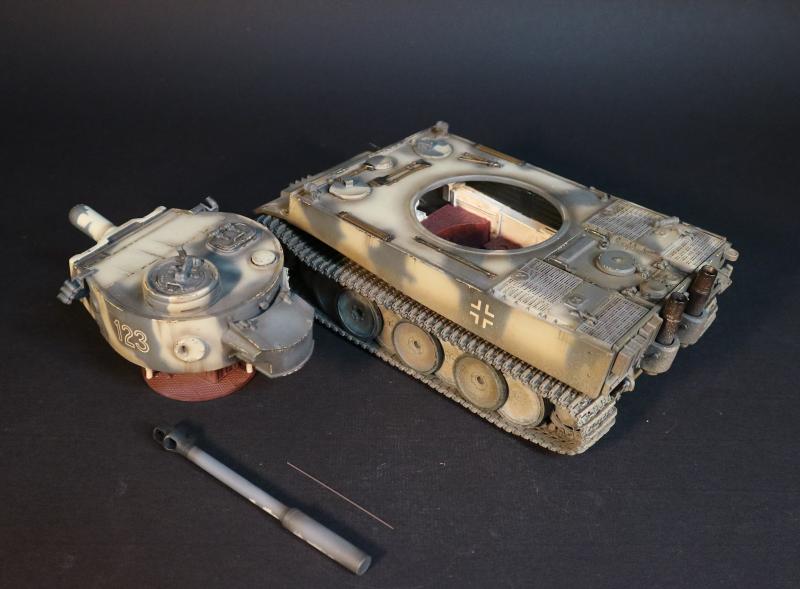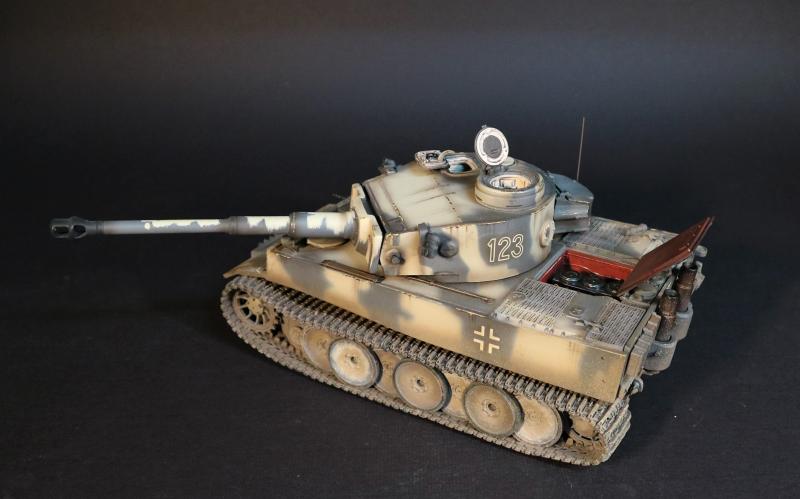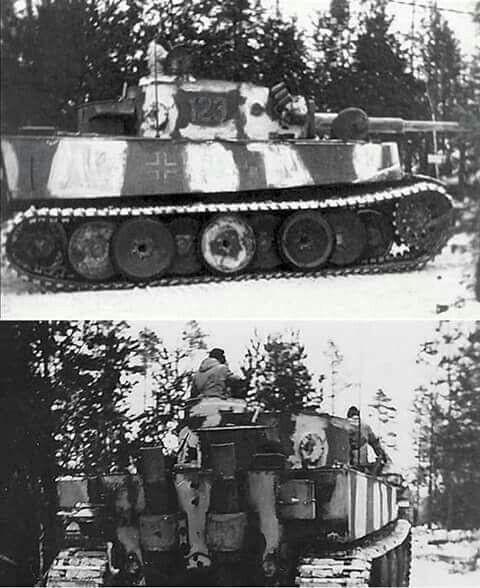German Panzerkampfwagen "Tiger" Ausf. E (Sd.Kfz.181), Tiger #123, schwere Panzerabteilung 502--RETIRED -- LAST THREE!
$448.00
Item Number: GA-52
German Panzerkampfwagen "Tiger" Ausf. E (Sd.Kfz.181), Initial Production, Tiger #123, schwere Panzerabteilung 502, Second Battle of Lake Ladoga, January 1943.
Without a doubt the most iconic tank of World War Two, the Tiger earned a deadly reputation and struck fear into the hearts of its Allied opponents in all theatres of war. Its undisputed battlefield superiority, based on its lethal cannon and superior armor protection, gained the Tiger an almost mystical reputation, particularly among its former enemies. Such was the fear of the Tiger that the sighting or mere mention of Tigers on the battlefield could cause enemy troops to panic.
JJD announce the release of the latest "big cat" and its first model of the iconic Tiger tank.
Design for the Tiger was carried out in earnest beginning in late 1939 with two competing designs by Dr.ing.h.c.F. Porsche K.G. of Stuttgart and Henschel & Sohn of Kassel (commonly referred to simply as Porsche and Henschel). The Porsche prototype incorporated a Krupp designed turret mounting an 8.8cm KwK / L56 gun while the Henschel design used a Rheinmetall turret mounting a 7.5cm KwK / L70 gun. The Rheinmetall designed Tiger turret was significantly smaller than the Krupp design and looked strikingly similar to the turret used on the later Panther. Of the two hull designs, the Porsche hull was much more technologically advanced. It envisioned use of electric engines and either an electric or hydraulic transmission whereas the Henschel design utilized a standard (yet powerful) gasoline engine and mechanical transmission. Due to a number of factors, including automotive design problems with the Porsche Tiger, Krupp's ability to maintain a monopoly on tank gun production, and the ease with which the Henschel chassis could be modified to accept the larger Krupp turret designed for its competitor, the final Tiger became a combination of the Porsche and Henschel designs. The 8.8cm / L56 gun Krupp turret (originally designed for the Porsche Tiger) was mated to the Henschel Tiger chassis...and gave us the legendary Tiger appearance. (Interestingly, a single complete Porsche Tiger served as a command tank and saw combat use with the schwere Panzerjager Abteilung 653, who were equipped with the Ferdinand/Elefant tank destroyer that used the Porsche Tiger chassis.)
Following the Second Battle of Lake Ladoga, the Russians launched Operation Polar Star, whose aim was to completely lift the Siege of Leningrad. From February to March of 1942, s.Pz.Abt 502's effectiveness increased as it supported numerous infantry divisions in defensive operations. Notable actions occurred on 11 February, when three Tigers and three Panzer IIIs supported the SS-Polizei Division at Mischkino and knocked out 32 Russian tanks. Another notable action occurred on 17 February, when the Abteilung's Tigers knocked out 10 Russian KV-1 heavy tanks in the matter of a few minutes. Operation Spark failed, and while a land connection remained intact, Leningrad remained under siege until 27 January 1944. Following these introductory battles, s.Pz.Abt 502 would subsequently be upgraded to a full Tiger Abteilung complete with three companies of Tiger tanks. s.Pz.Abt 502 would continue to fight on the Eastern Front until the end of the war, where its kill continued to climb. In total, s.Pz.Abt. destroyed 1,400 Soviet tanks for the loss of 105 Tiger Is and 8 Tiger IIs. The Abteilung's Tiger Aces included Oberleutnant Otto Carius (150 kills), Hauptmann Bölter (144 kills) and Feldwebel Kerscher (100 kills).
Following these initial combat operations, the s.Pz.Abt 502 saw a period of relative quiet in November and December, where maintenance and refitting was conducted and the Tigers and Panzer IIIs received winter camouflage consisting of large bands of whitewash painted over their Dunkelgrau basecoats. Additionally, the Tigers were fitted with sheet metal smokestacks over their engine exhausts, to hide the exhaust flames, which could be seen from a good distance. Then in January of 1943, the Russians launched Operation Iskra (Spark); named the Second Battle of Lake Ladoga by the Germans. The intent of Operation Spark was to create a land connection and partially lift the siege of Leningrad. During the Second Battle of Lake Ladoga, s.Pz.Abt 502 combat effectiveness rose while conducting defensive operations supporting various infantry divisions. One notable action near Goro-Dok on 13 January was a counterattack by four Tigers and eight Panzer IIIs in support of Grenadier Regiment 283 of the 96. Infanterie Division that destroyed twelve T-34s with the loss of zero German tanks. In total, the s.Pz.Abt 502 destroyed 55 enemy tanks during the battle.
The JJ Designs Tiger represents Tiger #123 of s.Pz.Abt. 502, as it appeared during the Second Battle of Lake Ladoga in January 1943. One of the initial Tigers produced, it carries the distinctive features of these early tanks along with those of s.Pz.Abt. 502:
- early turret with two rear pistol ports and no escape hatch
- early style smooth gun mantlet
- early style thin front mudguards
- a Panzer III Rommelkiste (turret stowage bin) fitted to the rear of the turret
- no side mudguards, because Tiger #123 was produced without mounts for them
- elongated sheet metal smokestacks fitted to the engine exhaust (a field modification unique to s.Pz.Abt. 502)
- the forward outer road wheels removed; this modification was employed by multiple Tiger units on the East Front to aid in minimizing the buildup of dirt and mud in the tracks
- Dunkelgrau base paint color with wide bands of winter whitewash
- s.Pz.Abt. 502's "Mammut" (Mammoth) unit insignia painted on the right front glacis plate and above the rear turret stowage bin
- white outline numbers and Balkenkreuz
Many thanks once again to Steve “Hunter Rose”…. for everything.
Released in APRIL 2024.
RETIRED.
LAST FOUR!!




